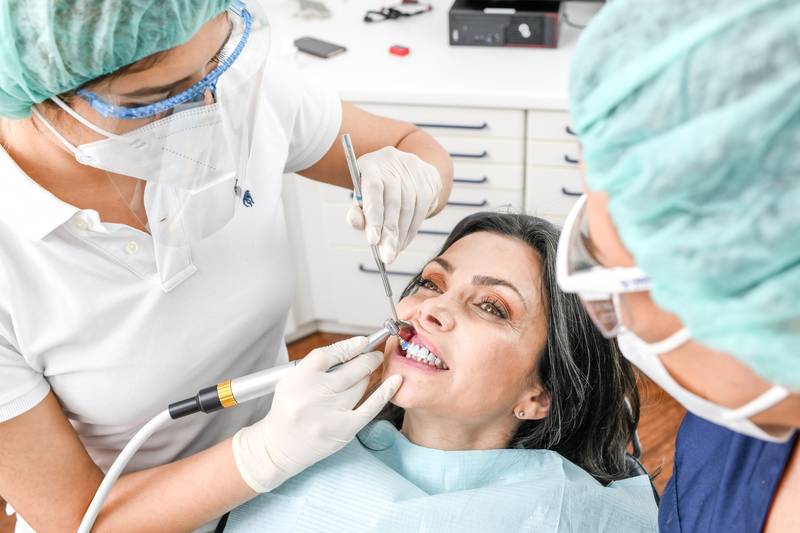Today, the use of dental digital processes is a largely self-evident part of the daily routine in dental laboratories. As a result, individual process steps can be eliminated and the quality of processes and results can be improved. This is why innovations and trends in digital manufacturing processes will take up a lot of space at the IDS 2015, and are guaranteed to gain most of the visitors’ attention. “This technological evolution is fundamental for the industry, and it demonstrates rapid developmental progress for dental-prosthetic rehabilitation measures. For that reason, this digital ‘state of the art’ for dental laboratories will be one of the key topics of the IDS 2015”, says Dr. Martin Rickert, Chairman of the Verband der Deutschen Dental-Industrie VDDI (Association of German Dental Manufacturers).
The digital laboratory process chain begins with the preparation data, which have been scanned at the dental practice: these can then be directly integrated into the laboratory’s design software. This means they can be processed further in the laboratory – using data sets which have been recorded with intraoral scanners (IOS) – or data sets which have been generated via scanned-in impressions. As a result, individual process steps can potentially be eliminated — i.e. whenever the manufacture of a model can be avoided — because the work can be completed without models.
However, preparation data of impressions or models are still much more frequently generated by desktop scanners. The equipment is used to scan in working documents, and scans may subsequently be used as a virtual working document for designing crowns, bridges, abutments or the bases of dentures. Besides, many scanner types also allow the scanning of models while these are still being held in the articulator. Using this kind of virtual technology, dental technicians can check the fit and occlusal contact of their work in the articulator, in exactly the same way as they are used to with their analogue equipment. The object designs can be viewed from all sides on-screen using a computer mouse and control keys, and if necessary, they can also be corrected. The great thing about it: the zoom function allows for easy and detailled identification of the articulatory movements and possible interfering contact. Equally, data generated from electronic maxillomandibular relationship records can be integrated into numerous design software products. This helps with displaying a patient’s chewing movements in the virtual articulator, and with taking them into account in the restoration design.
For many prosthetic restorations, on-screen digital work has replaced the manual working techniques using modelling instruments and brushes. Object designs, such as crowns, bridges, abutments or bases of dentures, are built up biomimetically, are selected and modified from image databases, or designed free-hand. And in all cases a computer mouse is used. For the most part, it has replaced the conventional instruments of a dental laboratory, and is now the medium used to add unique and individual touches to the technician’s work.
Furthermore, special software is available for various indications: alongside software for designing crowns and bridges, there is also software for designing abutments and conical crowns. But such design tools are also available for removable bases of dentures – known within analogue dentistry as model casting. Throughout the evolution of dental software, designs have been integrated into these options, which ensure the long-term durability of the restorations. So, for instance, anatomically reduced tooth profiles, oval connectors or emergence profiles which are freely adjustable within their dimensions.
Whether three, four or five-axis machines are demonstrating their particular strengths in undertaking their respective tasks, whether with or without an additional setting angle – the widest variety of equipment is used to manufacture restorations within the in-house laboratory via milling and grinding work. The IDS 2015 will also demonstrate all of the latest developments in CAM technologies. These machines can manufacture all dental frameworks – and the five-axis milling or grinding contact surfaces operate so that time and materials are saved. Furthermore, geometrically complicated framework forms can also be produced.
But it is also possible to manufacture the frameworks using a special “workbench extension”: the industry partner. This approach will save the costs of investing in equipment, and stocking up with blanks or metal alloy powders. Also, as a result, the client incurs no costs for setting up, or manufacturing items over and over again. The services are mostly used for manufacturing objects made of zirconium dioxide or of non-precious dental metal alloys with cobalt chrome as well as titanium. Production is done via milling processes or additive manufacturing. Generally, clients receive their orders within 48 hours: for the final plating, e.g. for veneering and high-gloss polishing, or, as with removable partial denture prosthetics, for completion of dentures and plastic saddle bridges.
The additive manufacturing, i.e. the constructive and generative manufacture of objects, still remains predominately limited to the industrial manufacture of crowns, bridges and bases of dentures via laser sintering. However, machines are already on offer for manufacturing in the in-house laboratory, too, and the IDS 2015 will demonstrate what innovations are available for this dental manufacturing option. There is yet another reason for demonstrating the additive manufacturing approach, though: it is model manufacturing using laser sintering or stereolithography. This field of application is of great importance in dental digital workflows with impressions of the preparations via intraoral scanners – in particular for all restorations which cannot be manufactured without models.
“Dentists, practice staff, as well as dental technicians can attend the International Dental Show (IDS), the world’s largest trade fair for dentistry and dental technology, in Cologne from 10 to 14 March 2015, and inform themselves in an optimal way about the current status of the ranges available for the digital practice. Exhibitor specialists, experts and experienced users will be prepared to exchange information”, says Dr. Markus Heibach, Executive Director of the Verband der Deutschen Dental-Industrie VDDI (Association of German Dental Manufacturers).
IDS takes place in Cologne every two years and is organised by the GFDI Gesellschaft zur Förderung der Dental-Industrie mbH, the commercial enterprise of the Association of German Dental Manufacturers (VDDI) and staged by Koelnmesse GmbH, Cologne.
Note for editorial offices:
Photos from the last IDS Cologne are available in our image database (Image database) on the Internet at www.ids-cologne.de, “For the Press”.
If you reprint this document, please send us a sample copy or link.



